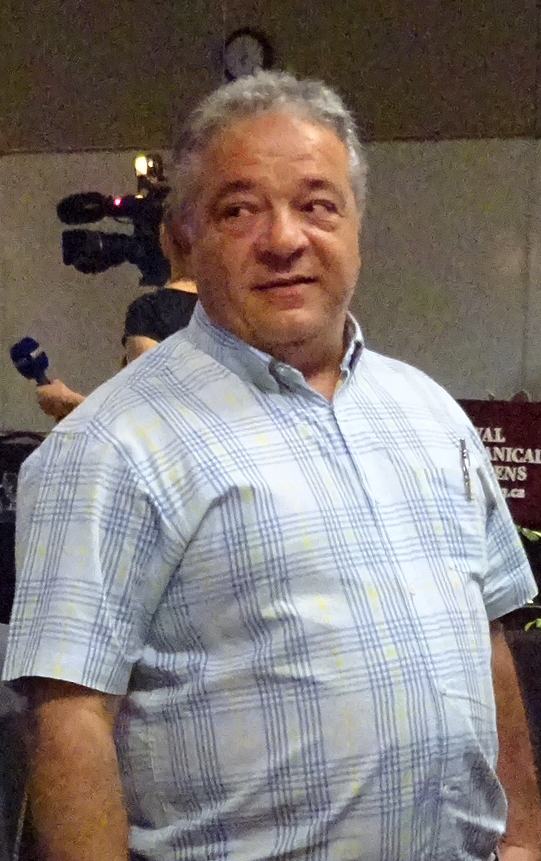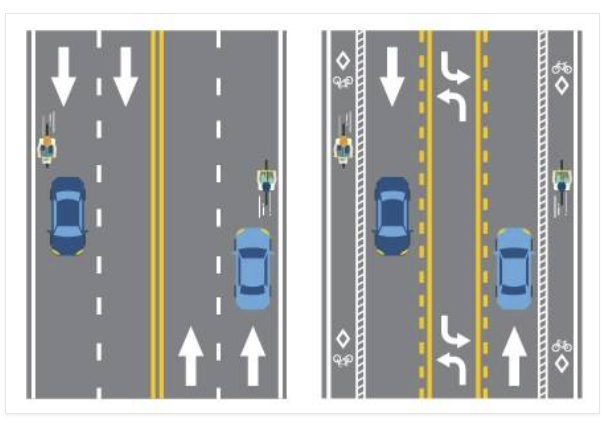 By Pepper Parr
By Pepper Parr
August 30th, 2016
BURLINGTON, ON
The heat is clearly on – staff in the city’s transportation department have taken to thanking people who have used various means of communication to let the city know how they feel about the “road diet” New Street has been put on while the city experiments with dedicated lanes for bicycles on the north and south side of the street between Guelph Line and Walkers Line.
The decision to spend the $250,000 on the pilot project was made by city council July 18th.
It is a change – and people don’t really like change – particularly in Burlington.

Director of Transportation Vito Tolone is a well informed on transportation matters. What he could not be expected to know was how the public was going to react to the idea of putting dedicated bicycle lanes on New Street. Members of council are supposed to know what their constituents think.
In a media release the city said they wanted to thank the hundreds of people who have taken time to comment about the New Street road diet one-year pilot program and assure people that their comments are part of the findings of the pilot.
The Gazette recorded more than 60 comments to which we add the 21 that we did not publish due to the offensive language; some people got very exercised over this one.
It is unusual for city hall to put out a media release – before a project has had a chance to create some data. While there will be data – right now there is just a lot of noise.
Vito Tolone, director of transportation for the city said: “We are hearing what residents have to say, responding to a variety of questions and reading and collecting each comment to include in our pilot findings.” He adds that the “road diet is a one-year pilot program that aims to create a complete street that allows for multiple forms of transportation and enhances the safety of the road for motorists, cyclists and pedestrians.
“Through the city’s strategic plan process, we heard from residents who told us they would like safer places to cycle and more transportation choices when it comes to getting around their city,” said Tolone. “Throughout the one-year pilot, the city is using technology to track all forms of transportation along this stretch of New Street, including cyclists, pedestrians, buses and cars. We will also be collecting data on the average speed travelled and the number of collisions to help us understand how the road is being used.”

Six of the seven voted for the New Street Road diet – Councillor Sharman voted against the pilot project.
Tolone said his department is going to collect “four seasons of data in 2017”; one can only hope that with the uproar, and this is certainly an uproar, that the city will not wait until it has all the data in hand – regular reporting to the public goes a long way to meeting that “transparency and accountability line” that the city trots out regularly.
The pilot looked like a reasonable approach – what neither council nor staff was prepared for was the reaction – most of it before the pilot really had a chance to start. Council voted 6-1 for this (Sharman voted against it – what does he know that the other six don’t know).

Existing lane configuration on the left – the road diet on the right.
New Street is due to get a new asphalt surface in 2017 – council thought this was a good time to do a pilot project before they began laying down the new surface, when the section of New Street between Guelph Line and Walkers Line is scheduled to be resurfaced.
Conducting the pilot project before this work takes place means there will be no added cost to either return the road to its current setup if the pilot is not successful, or to keep the new bike lanes if the pilot program is adopted.
The pilot project now has the distinction of having a page of its own on the city web site. For more information about the New Street road diet, including responses to some of the most frequently asked questions from the community about the pilot, please visit www.burlington.ca/newstreetdiet.




















Given that it takes about 6 minutes to travel this section of New Street allowing for stop lights and reasonable traffic flow, if you saw 4 cyclists during that time, that would translate to about 40 per hour, or roughly 200 per day if that in fact is the high volume hour of the day.
Also consider the fact that school is not in session yet, and students generally cycle more frequently than other members of the community.
You forgot the other trips on which I saw only 1 cyclist. Most of the time I can quote Mel Lastman, ‘NOBODY”!
Saturday, Sept. 3rd was a wonderful day to be in the great outdoors. The high heat and humidity had taken the day off. With traffic on the QEW at a standstill, I decided to patronize New Street as I headed west towards Ribfest.
I expected to see fleets of cyclists enjoying the motorists’ gift of a safe and healthy road diet.
In truth, I saw just one — and he was driving on the sidewalk!! Mind you, I didn’t see any unicorns or leprechauns either. Gotta hand it to those generous folks at City Hall for seeing things mere mortals can’t.
I was expecting to hear tales of the traffic on New being backed up all the way to Walker’s Line, but alas, nothing of the sort.
From what I’ve observed, even when Lakeshore, Fairview, and the QEW are all backed up, New Street is still flowing well. So what harm has been inflicted by asking motorists to share some of the excess road capacity? Cyclists got a place to ride. Pedestrians now have fewer lanes to cross. And everyone got a safer street out of it.
I was expecting to hear tales of hundreds of cyclists using the New Street bike lanes daily but alas nothing of the sort.
I haven’t sat and counted but I wouldn’t be surprised if there are a couple hundred a day. I’m certainly seeing more on the street than I ever did before.
Nice try, James! I live nearby and travel along New Street several times a day except at rush hour. The most I’ve seen is 4 (and predictably they were all TdeF Wannabes); however, if you station yourself near the Centennial Pathway you’ll see lots crossing New Street. I suspect both you and the mayor will count them as using New Street to pad the stats.
By the way, at rush hour, the wait to get out of Pine Cove is far too long and I drive east to shop (too bad for Roseland Plaza stores).
You cannot improve water flow by pinching the hose. Motorized vehicles make up 99.9% of the traffic on our roads. Bicycles make up 0.1%. Based on how Burlington planners laid out the city, and the make-up of Burlington’s population, that’s not going to change anytime soon. So why are we doing this? Let’s say the bicycle ridership multiplies by a miraculous 500% because of this pilot program. Is that considered success? That still puts bicycle ridership at less than 1%. Apparently only Sharman’s done the math and understands the potential upside of this pilot program just does not justify the tax dollars that are being wasted, or the additional frustration being thrust upon the 99.9%. And make no mistake, our tax dollars are being wasted here. I have no issue with change, but I do have an issue with stupidity.
The point of this pilot project is to quantify the “additional frustration”. Is it acceptable given our goals of having roads that all residents can use and encouraging more active travel that saves taxpayers money in the long run?
Drove New St. yesterday afternoon, just before the start of the rush, maintained a steady speed of 60 km/h from start to end. No frustration to speak of, even though there was construction still ongoing. 3 cyclists on the opposite side, looked like a mom & two young teens. Granted it won’t always be so smooth, but 23 out of 24 hours a day should be no issue at all for drivers.
Lots of concerns from a cycling perspective also – chiefly the fact that the lanes don’t yet connect up with New St. east of Guelph Line, or with the existing bike lanes on Guelph Line & Walkers Line. Also have to reiterate the need for planters or dividers in the buffered areas to provide some protection that will encourage younger and less experienced riders, not to mention making the street look less ugly.
I think success is based on the fact that the lanes are available for all to use. We know the bike riders will come over time. The little issues that inevitably happen – light timings, intersection layouts, signage, etc. will get fixed. The impact on the operations of the buses and the impact on safety for all users – including pedestrians, cyclists and motor vehicles, as well as the difference in rush hour travel times are the immediate tests that determine how to go forward.
BTW, Councillor Sharman was very much in favour of the cycle track option, which would be an excellent option for New Street – if only we didn’t also require funding for a large number of other important links that connect the city.
I still believe that the bigger issue has become how a special-interest lobby group, funded/sponsored by the City, and representing less than 1% of road users,
can so influence the Mayor & Council that they enact changes that are detrimental to the other 99% of road users. This is a complete affront to democracy in this City.
Gotta love the Orwellian term being used, “road diet” Why not the more accurate “lane restriction”?
In 1950, the socialist government in England proposed changing the word “home” to “accommodation unit”. Sir Winston Churchill’s cutting response was how was he supposed to sing, “Home, Sweet Home”; “accommodation unit, sweet accommodation unit”? He ended his cutting rebuttal of this use of socialist jargon with the comment, “I hope to live to see the British democracy spit all this rubbish from their lips”. In Burlington, apparently the rubbish still exists.
According to Mr. Tolone:
” He adds that the “road diet is a one-year pilot program…”
So what are we going to do at the end of the pilot if it isn’t successful? Spend another $720K to put it back the way it was? Does he really think that any of us who disagree with this proposal take him or this Council at their word to rectify this later? Wouldn’t it have been more prudent to put the question to voters in the form of a survey or plebiscite first and let them decide…or do the opinions of the majority not count?
Again, from the article:
” “Throughout the one-year pilot, the city is using technology to track all forms of transportation along this stretch of New Street, including cyclists, pedestrians, buses and cars. We will also be collecting data on the average speed travelled and the number of collisions to help us understand how the road is being used.”
Frankly, I don’t give a damn about the average speed travelled. What I want to know is: (a) increased commuting time; (b) the amount of pollutants emitted while idling in traffic; (c) the dollar costs associated with a longer commute. If we build bicycle lanes to service a handle of riders, and the end result is that it costs us thousands of dollars more in wasted fuel and extra pollution, how is that serving the environment?
From the article:
“Council voted 6-1 for this (Sharman voted against it – what does he know that the other six don’t know).”
Gee, I don’t know. Maybe Councillor Sharman actually listens to the concerns and interests of his constituents…quite unlike the Mayor, the Council and the public servants at City Hall.
As any high school physics student knows, v (velocity) = d (distance) / t (time). The distance is constant: 2 km. Average time, increased delay, or whatever you care about can easily be calculated based on the average speeds measured before and after this change.
The road is being ripped up and repaved next year anyway, so there’s no extra cost to put it back the way it was, as clearly explained in the article.
Sometimes I wonder if the commentators on here even bother to read the article, let alone drive down this street.
Thought city may have relocated the experiment at the least. I also thought i read a cyclist rode the distance in 49 sec? Doubtful as my car with me driving took longer (looking and watching and making sure distance between).
If any exeriment should be Appleby yo Bronte Rd
Should hope it takes everyone longer than 49 seconds. 🙂
Perhaps possible if the cyclist was travelling at 171 km/h. Maybe the video was 49 seconds in time-lapse mode?